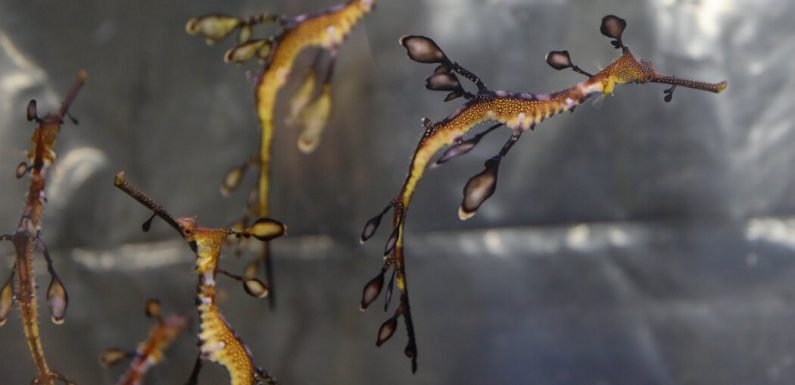
For more than a decade, researchers at the New England Aquarium in Boston have been trying to breed some of the most elusive and enchanting fish under the sea. Lacy and delicate, sea dragons live only in the waters along Australia’s southern coast, and their small habitat and limited range make them an ideal candidate for in-captivity breeding.
Since 2008, the aquarists have tried to replicate the sea dragons’ natural habitat. They have changed the temperature of the sea dragon tank to match the seasons of the southern hemisphere. They have adjusted the amount of light in the exhibit. They got a taller tank. None of it worked.
“I had kind of given up and thought it’s never going to happen,” said Jeremy Brodt, an aquarist and galleries manager at the New England Aquarium.
And then, “out of the blue,” Mr. Brodt said, “it happened.”
Last May, aquarium staff members discovered that a male weedy sea dragon was successfully carrying his mate’s eggs. The aquarium announced on Wednesday that the eggs had hatched in mid-July, and that aquarists have been raising 18 baby dragons since then.
It is the first time the New England Aquarium has successfully bred and hatched the weedy variety of the species, and one of about 15 instances of scientific institutions breeding sea dragons in the past 30 years, when sea dragons first appeared in aquarium displays, Mr. Brodt said. The Birch Aquarium at the Scripps Institution of Oceanography in San Diego celebrated the arrival of more than 70 weedy sea dragon babies a few weeks ago.
Aquarists hope that breeding these fickle creatures in captivity will lead to fewer sea dragons being collected from their native sea grass habitat, which is under increasing stress from climate change and runoff from storms. Sea dragons, which are primarily of the leafy or weedy varieties, are not currently threatened, but the Australian government has strict regulations that allow only a limited number of them to be collected for public display in aquariums. Still, scientists are worried that the animals’ already limited habitat may be contracting.
“They’re a great, phenomenal animal, they get people’s attention,” Mr. Brodt said. “It’s a way to get that message across and talk about these unique animals and the issues that they’re facing.”
That is easier said than done, in large part because of the mysteries surrounding their optimal — and very complicated — mating habits.
Like their sea horse cousins, male sea dragons are responsible for carrying the species’s eggs to term and can have more than 150 eggs attached to their tails. Their elaborate mating ritual involves male and female sea dragons mirroring each other, moving together as they spin upward through the water. During their dance, the female sea dragon transfers her eggs to a patch on the underside of her partner’s tail, where he fertilizes and carries them. If the transfer is interrupted somehow — by competing love interests, for example, or even clumsiness — the eggs may drop or end up unfertilized.
No one has ever seen a leafy sea dragon in the wild, and aquarists have not been able to breed them in captivity.
To protect the male sea dragon from bumping the eggs off his tail, aquarists at the New England Aquarium moved him to his own smaller holding tank to be monitored. Once the eggs hatched, the team gently removed the baby sea dragons and placed them in a tank stocked with highly nutritious food. The young sea dragons do not have names (they look too much alike), but researchers are monitoring their behavioral patterns.
Today, the 8-month-old sea dragons are about six inches long and may grow up to a foot long. The aquarium plans to put them on display this summer.
“They’re pretty impressive specimens when they’re adults,” Mr. Brodt said. “That first year, it’s crazy. They’re about two centimeters when they hatch and look like floating grape stems. They grow about one centimeter a week for several months.”
So what made this a successful pregnancy?
The researchers were considering moving some of the adult sea dragons out of their display and into a larger tank to give them more space to float when they discovered the egg transfer had already occurred in the existing exhibit. Two developments may have helped the breeding effort, Mr. Brodt said: The aquarium had a surplus of live food to dole out (adult sea dragons are primarily fed frozen food with some live supplements), and because of natural population fluctuations, there were fewer sea dragons in the tank at the time.
“It could have been eating at the right time and getting this influx of nutrition,” he said. “It could have also been pure luck and everything worked.”
Greg Rouse, a marine biologist at Scripps who was not involved in the New England Aquarium’s project, said both food and space were likely factors in the success.
Because sea dragons “bond up as pairs in the wild and they don’t hang around in big groups, maybe they get a little bit disturbed if there’s too many in a tank with them,” Dr. Rouse said. Food quality, he added, was “certainly” a factor.
Even so, the hormonal “synchronization” between a male and a female has to line up perfectly. Moon phase and water temperatures also probably play a role in their reproduction.
The success of one aquarium is a success for all, Dr. Rouse said.
“Anything that will take pressure off sea dragons, the better it is,” he said.
Source: Read Full Article